-

人教版高中英语必修2Cultural Relics说课稿2篇
Ⅲ. Analysis of the teaching material:The topic of this unit is cultural relics. Students are quite interested in topics about different cultures around the world. This is the second period of the whole unit. As a reading class, the passage mainly talks about the history of the amber room (how it was made, sent as a gift, lost and rebuilt).According to the new national curriculum, when teaching reading, much emphasis should be put on training the students’ reading skills.Ⅳ. Teaching objectives1. Language objectives:1) Students are required to master the key words and phrases occurred in the passage (e.g. amazing, decorate, belong, in return, less than etc.)2) Students are required to learn the attributive clause and acquire the sentence pattern.2. 1) Students are required to describe a certain thing by using the new sentence patterns.2) Students are required to master two kinds of reading skills—skimming and scanning, and learn to use them in their daily reading.3. 1) Students are required to know the history of the amber room.2) Students are required to appreciate cultural relics and understand the importance of protecting them.Ⅴ. Teaching important and difficult points1) the new words, phrases, and sentence pattern in the course of reading.2) Teaching difficult point: Help the students master two kinds of reading skills—skimmingand scanning and learn to apply them in daily use.Ⅵ. Teaching methods:Task-based method & Top-down model Ⅶ. Teaching aids: PPT, pictures, blackboard Ⅷ. Teaching procedure:

人教版高中英语必修3Festivals around the World说课稿3篇
Teaching plan for Unit 1 book3Good morning, teachers. It’s my great pleasure to be here because I can share my lesson with you and I can learn a lot from it. I’ll begin my lesson from the following four parts, the teaching material, the teaching methods, the studying methods and the teaching procedure.Firstly, let me talk about the teaching material. The content of my lesson is the reading passage festivals and celebrations of Unit 1 Festivals around the world. This passage is about festivals and celebrations. By studying this passage, we’ll enable the students to know that festivals exit everywhere, and many of festivals in different countries celebrate similar ideas. As we all know, the reading passage is the center of each unit. If the Ss can learn it well, it will be helpful to make the Ss learn the rest of this unit.After studying the teaching material, I think the teaching aims are as the followings:1. Knowledge aims:(1) The Ss can master the usage of the important words andexpressions.(2)The Ss can use the __________________ (grammar) in the proper situation.Make students know about the festivals all over the world and the detail of the festivals, such as origin, content, and the date of the holiday festivals.2. Ability aims:(1) Students can talk about festivals and celebrations in English(2) To improve the student’s reading ability, especially their skimming and scanning ability.3. Emotion aims:Make the Ss know about the foreign festivals, and respect other countries’ custom.Next, let’s come to the important points and the difficult points.The important point is how to make the Ss understand the text better and the difficult point is how can they talk about it. secondly, Teaching Methods:1. task-based Language Teaching2. Computer assisted language teaching.3. question-and–answer methodThirdly, Studying Methods:

人教版高中英语必修4Theme parks说课稿3篇
The oldest and the most popular park in the worldenjoy the exciting activities thereget close to the life-size cartoon characters like Mickey Mouse and Donald Duck Step 3 Pre-reading1.What do you suppose a theme park is ?2.What do you think you can see in a theme park?(1.It is a kind of amusement park which has a certain theme – that the whole park is based on. 2.buildings, castles, statues, rare animals and birds, and so on.) Step 4 Reading ----- Theme Parks –---- Fun and More Than Fun1.Predict : Read the title and the pictures on P. 34 and PredictWhat is the meaning of the title “Theme Park – Fun and more than fun”?(The title means that theme parks are fun to visit, but that they can also be educational and can offer useful information.)2.Skimming Fast read and answer:What activities can we take in a theme park?Amusement park: Bumper car Merry-go-round slide bungee jumping Free-fall rides Horror films Pirate ship Ferris wheel roller coaster3.Scanning Read again and you will find various theme parks are mentioned in the passage . Then what are they ?Theme parks: Sports theme park History theme park Culture theme park Marine or Ocean theme Park Future park Science theme park Disneyland4.Careful reading and find the main idea of each paragraph:THEME PARKS---- entertaining/ educationalPara.1 Traditional parks are places to go for relaxation and to have time away from our busy lives.Para.2 Theme parks are different They’re large and full of things to do, see and buy.Para.3 Theme parks are built around a single idea or theme. One example is a sports park.Para.4 Another kind of theme park is historical more and cultural and can be educational.Para.5 Disneylandwas the first theme park. It is based on the fantasy life and characters of Disney’s films.Para.6 Some examples of educational theme parks include sea world parks and science parks.

人教版高中英语必修5Making the news说课稿4篇
今天我们来介绍一下必修五第四单元的授课方式。这个单元的题目是Making the news。应该是学生比较感兴趣的话题,学生往往对新闻工作充满好奇,所以我们可以利用这个机会多设计一些师生互动和学生互动,来激发起学习的积极性,提高学习效率。同时我们可以利用这个单元不仅帮助学生掌握语言知识,培养语言能力,同时让其了解新闻工作的重要性,培养起社会智能感。这个单元分为六个课时,它的教学目标是这样的:语言目标是掌握词汇表中的常用单词和短语,掌握倒装句的一些基本用法。 技能目标是能初步掌握约会的基本句型并在真实的场景下正确运用。新闻报道类文章的写作技能。采访的基本规范和沟通技能。情感目标是对新闻报道的客观性和真实性有更好的理解。对新闻记者的职业有更深入的了解,并能体会其工作的重要性。下面我们来介绍一下第一课时的授课方式,第一课的教学目标是这样的第一课时的教学目标语言目标:单词:Occupation, journalist, editor, photographer, curious, personality, enthusiasm

人教版高中英语必修5The United Kingdom说课稿4篇
Teaching Aims:Knowledge 1. Get the students to learn the useful new words and expressions in this section. Aims:2. Let the students learn about how the UK was formed and the four groups of invaders.1. Develop students’ reading ability and let them learn different Ability reading skills. Aims:2. Enable students to learn to talk about the United Kingdom and the Union Jack Emotional 1. Let students know more about the UK2. Develop students’ sense of cooperative learning Aims:Teaching Important Points:1. Let the students learn about the countries of the United Kingdom and the Union Jack2. Get the students to read the passage and know about how the UK was formed and the four groups of invaders.3. Have the students learn different reading skills.Teaching Difficult Ponts:1. Develop students’ reading ability.2. Enable students to talk about the United Kingdom and the Union Jack.3. Let students learn how the UK was formed geographically and historically.Teaching Methods:Showing pictures, asking, exercising, listening, reading etc.Teaching Aids:A computer,a projector and a blackboard.Teaching Procedures: 1) Show a map of the world, ask students the following questions:Where is the UK?What’s the full name of the UK?2) Ask the students work in pairs to do the quiz on Page 9.Do you want to test how many things you know about the United Kingdom? Let’s have a small test.Using the map on P9, students answer the following questions:?How many countries does the UK consist of? What are they??England is divided into three main areas. Do you know what they are? 1) Scanning (10Minutes )Let the students hold the questions asked in pre-reading and read the passagequickly and then let them do the following exercise.Join lines to the right answer.
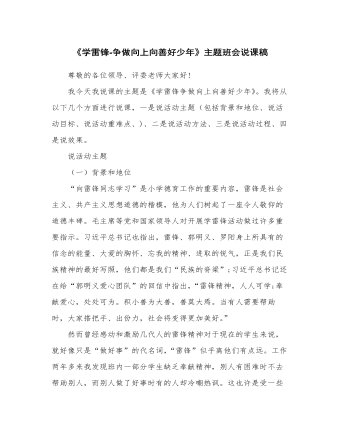
《学雷锋-争做向上向善好少年》主题班会说课稿
活动三——读《雷锋日记》让学生读雷锋给一位陌生老人送完手套后写的日记。重点理解“一路上,我的手虽冻得像针扎一样,心中却有一种说不出的愉快。”这一句话。让学生谈谈自己的感受。(此活动的目的是让学生了解雷锋的内心世界,理解雷锋精神的实质,全心合意为人民服务。)(三)讨论交流新时代还需要不需要学习雷锋?(1)小组讨论雷锋精神是不是已经过时了?新时代还用学雷锋吗?通过小组的讨论让学生认识雷锋精神的重要性,这是本次班会的重点内容,要引导学生积极参与,达到真正的思想教育。通过辩论后利用课件为学生们出示新时代的雷锋,《小林浩救人事迹》、感受社会的正能量。(设计本活动是让学生在讨论和辩论引起学生思想和情感的升华,更加深入理解雷锋精神对社会的重要性。)
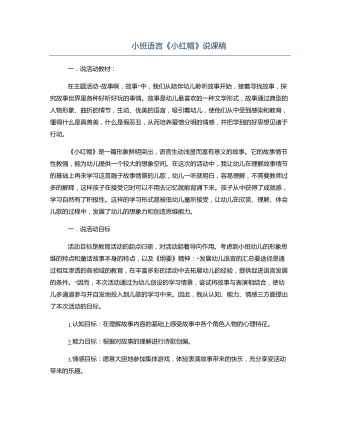
小班语言《小红帽》说课稿
在主题活动“故事啊,故事”中,我们从陪伴幼儿聆听故事开始,接着寻找故事,探究故事世界里各种好听好玩的事情。故事是幼儿最喜欢的一种文学形式,故事通过典型的人物形象、曲折的情节,生动、优美的语言,吸引着幼儿,使他们从中受到感染和教育,懂得什么是真善美,什么是假恶丑,从而培养爱憎分明的情感,并把学到的好思想见诸于行动。《小红帽》是一篇形象鲜明突出,语言生动浅显而富有意义的故事。它的故事情节性教强,能为幼儿提供一个较大的想象空间。在这次的活动中,我让幼儿在理解故事情节的基础上再来学习这首融于故事情景的儿歌,幼儿一听就明白,容易理解,不需要教师过多的解释,这样孩子在接受它时可以不用去记忆就能背诵下来。孩子从中获得了成就感,学习自然有了积极性。这样的学习形式易被低幼儿童所接受,让幼儿在欣赏、理解、体会儿歌的过程中,发展了幼儿的想象力和创造思维能力。
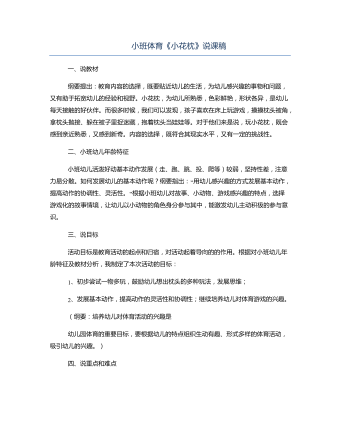
小班体育《小花枕》说课稿
纲要提出:教育内容的选择,既要贴近幼儿的生活,为幼儿感兴趣的事物和问题,又有助于拓宽幼儿的经验和视野。小花枕,为幼儿所熟悉,色彩鲜艳,形状各异,是幼儿每天接触的好伙伴。而很多时候,我们可以发现,孩子喜欢在床上玩游戏,摸摸枕头被角,拿枕头抛接、躲在被子里捉迷藏,抱着枕头当娃娃等。对于他们来是说,玩小花枕,既会感到亲近熟悉,又感到新奇。内容的选择,既符合其现实水平,又有一定的挑战性。小班幼儿活泼好动基本动作发展(走、跑、跳、投、爬等)较弱,坚持性差,注意力易分散。如何发展幼儿的基本动作呢?纲要指出:“用幼儿感兴趣的方式发展基本动作,提高动作的协调性、灵活性。”根据小班幼儿对故事、小动物、游戏感兴趣的特点,选择游戏化的故事情境,让幼儿以小动物的角色身分参与其中,能激发幼儿主动积极的参与意识。
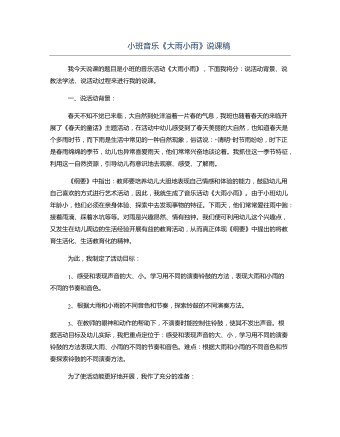
小班音乐《大雨小雨》说课稿
春天不知不觉已来临,大自然到处洋溢着一片春的气息,我班也随着春天的来临开展了《春天的童话》主题活动,在活动中幼儿感受到了春天美丽的大自然,也知道春天是个多雨时节,而下雨是生活中常见的一种自然现象,俗话说:“清明”时节雨纷纷,时下正是春雨绵绵的季节,幼儿也异常喜爱雨天,他们常常兴奋地谈论着。我抓住这一季节特征,利用这一自然资源,引导幼儿有意识地去观察、感受、了解雨。《纲要》中指出:教师要培养幼儿大胆地表现自己情感和体验的能力,鼓励幼儿用自己喜欢的方式进行艺术活动,因此,我就生成了音乐活动《大雨小雨》。由于小班幼儿年龄小,他们必须在亲身体验、探索中去发现事物的特征。下雨天,他们常常爱往雨中跑:接着雨滴、踩着水坑等等。对雨是兴趣昂然、情有独钟。我们便可利用幼儿这个兴趣点,又发生在幼儿周边的生活经验开展有益的教育活动,从而真正体现《纲要》中提出的将教育生活化、生活教育化的精神。
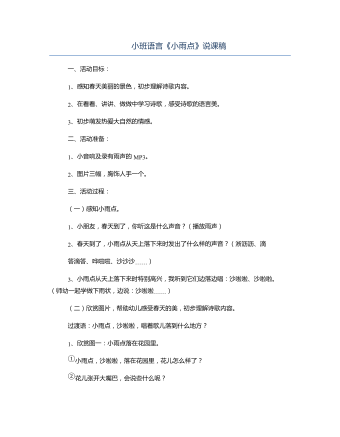
小班语言《小雨点》说课稿
欣赏图片,帮助幼儿感受春天的美,初步理解诗歌内容。过渡语:小雨点,沙啦啦,唱着歌儿落到什么地方?1、欣赏图一:小雨点落在花园里。①小雨点,沙啦啦,落在花园里,花儿怎么样了?②花儿张开大嘴巴,会说些什么呢?以诗歌内容小结:小雨点,沙啦啦,落在花园里,花儿张开大嘴巴。③师当小雨点,幼儿当花,边表演边学念诗歌第一段若干遍。2、欣赏图二:小雨点落在池塘里。①小雨点,沙啦啦,落在什么地方?池塘里有什么?他们在干什么?(摇尾巴)②它们的心情怎么样?你从哪里看出来?以诗歌内容小结:小雨点,沙啦啦,小雨点落在池塘里,鱼儿摇摇小尾巴。③师当小雨点,幼儿当鱼,边表演边学念诗歌第二段若干遍。
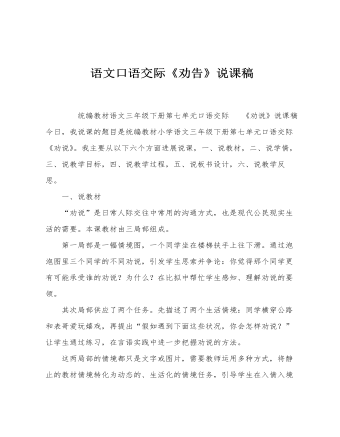
部编版三年级下册语文口语交际《劝告》说课稿
统编教材语文三年级下册第七单元口语交际 《劝说》说课稿 今日,我说课的题目是统编教材小学语文三年级下册第七单元口语交际《劝说》。我主要从以下六个方面进展说课,一、说教材,二、说学情,三、说教学目标,四、说教学过程,五、说板书设计,六、说教学反思。 一、说教材 “劝说”是日常人际交往中常用的沟通方式,也是现代公民现实生活的需要。本课教材由三局部组成。 第一局部是一幅情境图,一个同学坐在楼梯扶手上往下滑。通过泡泡图里三个同学的不同劝说,引发学生思索并争论:你觉得那个同学更有可能承受谁的劝说?为什么?在比拟中帮忙学生感知、理解劝说的要领。
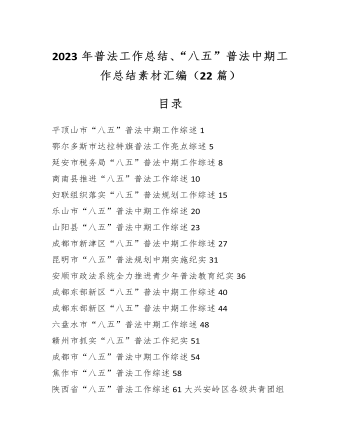
2023年普法工作总结、“八五”普法中期工作总结素材汇编22篇
作为全国公民法治素养提升行动8个试点地区之一,成都的试点工作目前正处于全面实施阶段。作为试点地区的一分子,新津区勇挑试点重担,在精准普法方面下功夫,第一时间制定试点工作方案,细化24条措施,新津区普兴街道岳店社区、新津实验高中被确定为成都市公民法治素养观测点位。在实施国家工作人员“法治提能”行动中,新津区将法治建设成效纳入区管领导班子和领导干部年度考核内容,区政府常务会开展会前学法72场次,全区66家单位接入四川省学法考法平台,共计2766名国家工作人员参与年度学法考法。实施青少年“学法筑基”行动的关键,就是要把法律知识变得有趣,让青少年听得懂、学得会、记得住。为此,新津区选派54名政法干警担任中小学校法治副校长,打造新津中学、新津一小、新津实验高中3个特色青少年法治教育阵地,并依托法治教育阵地开展专题教育活动180余场。
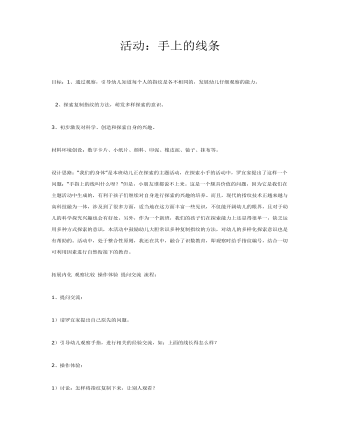
中班科学:手上的线条课件教案
2、探索复制指纹的方法,萌发多样探索的意识。3、初步激发对科学、创造和探索自身的兴趣。材料环境创设:数字卡片、小纸片、颜料、印泥、橡皮泥、镜子、抹布等。设计思路:“我们的身体”是本班幼儿正在探索的主题活动,在探索小手的活动中,罗宜家提出了这样一个问题:“手指上的线叫什么呀?”但是,小朋友谁都说不上来。这是一个颇具价值的问题,因为它是我们在主题活动中生成的,有利于孩子们继续对自身进行探索的兴趣的培养。而且,现代的指纹技术正越来越与高科技融为一体,涉及到了很多方面,适当地在这方面丰富一些见识,不仅能开阔幼儿的眼界,且对于幼儿的科学探究兴趣也会有好处。另外,作为一个新班,我们的孩子们在探索能力上还显得很单一,缺乏运用多种方式探索的意识,本活动中鼓励幼儿大胆常识多种复制指纹的方法,对幼儿的多样化探索意识也是有帮助的。活动中,处于整合性原则,我还在其中,融合了识数教育,即观察时给手指纹编号,结合一切可利用因素进行自然衔接下的教育。拓展内化观察比较操作体验提问交流流程:1、提问交流:1)请罗宜家提出自己原先的问题。
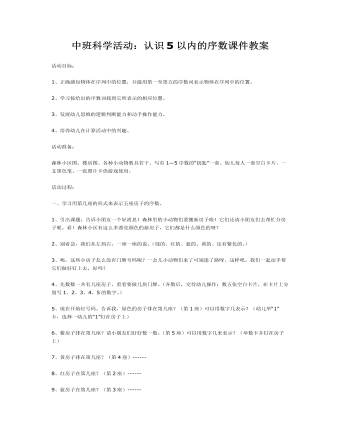
中班科学活动:认识5以内的序数课件教案
2、学习按给出的序数词找到它所表示的相应位置。3、发展幼儿思维的逻辑判断能力和动手操作能力。4、培养幼儿在计算活动中的兴趣。活动准备:森林小区图、楼房图、各种小动物教具若干、写有1—5序数的“钥匙”一套、幼儿每人一套空白卡片、一支黑色笔、一张照片卡供游戏使用。活动过程:一、学习用第几座的形式来表示五座房子的序数。1、引出课题:告诉小朋友一个好消息!森林里的小动物们要搬新房子啦!它们还请小朋友们去帮忙分房子呢。看!森林小区有这么多漂亮颜色的新房子,它们都是什么颜色的呀?2、别着急,我们从左到右,一座一座的说。(绿的、红的、蓝的、黄的、还有紫色的。)
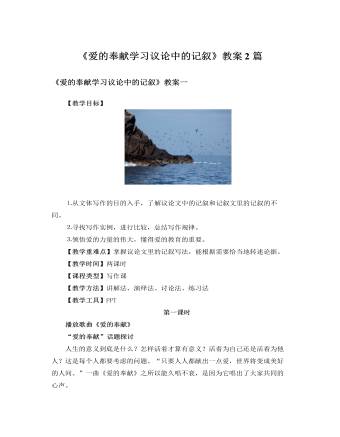
人教版高中语文必修3《爱的奉献学习议论中的记叙》教案2篇
方法点拨教师:有的同学叙述事实论据时,不突出重点和精华,不注意取舍,水分太多,有许多的叙述描写,有时还有详细的故事情节,文章几乎成了记叙文,使文章的论点无法得到充分的证明,这是写议论文的大忌。那么:议论文中的记叙有哪些特点?同学各抒己见。投影显示:1.议论中的记叙不是单纯的写人记事,记叙文字是为议论服务的,其目的是为作者所阐明的道理提供事实依据。所以,在记叙时要求简洁、概括,舍弃其中的细节,仅仅交代清楚事件或者人物的概貌即可,一般不在各种描写手段上下功夫,只要把能证明观点的那个部分、侧面交代清楚就行了。2.议论文中的记叙性文字不得超过总字数的1/3,否则视为文体不当。能力提升一、教师:了解了议论文中的记叙的特点,接下来我们看看今天的话题:“爱的奉献”,你想从哪个角度立论?有哪些素材?
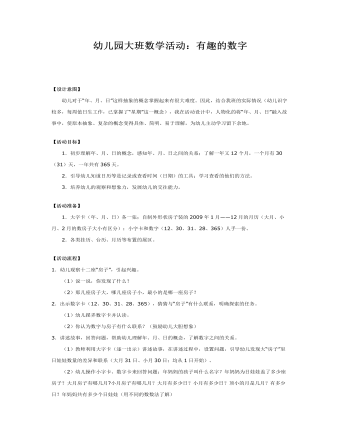
大班数学教案:有趣的数字
【活动目标】1.初步理解年、月、日的概念,感知年、月、日之间的关系;了解一年又12个月,一个月有30(31)天,一年共有365天。2.引导幼儿知道日历等是记录或查看时间(日期)的工具;学习查看的他们的方法。3.培养幼儿的观察和想象力,发展幼儿的交往能力。【活动准备】1.大字卡(年、月、日)各一张;自制外形状房子装的2009年1月——12月的月历(大月、小月、2月的数房子大小有区分);小字卡和数字(12、30、31、28、365)人手一份。2.各类挂历、台历、月历等布置的展区。【活动流程】1.幼儿观察十二座“房子”,引起兴趣。 (1)说一说,你发现了什么? (2)那几座房子大,哪几座房子小,最小的是哪一座房子?2.出示数字卡(12、30、31、28、365),猜猜与“房子”有什么联系,明确探索的任务。
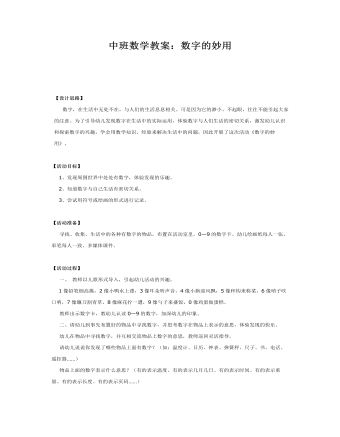
中班数学教案:数字的妙用
【活动目标】 1、发现周围世界中处处有数字,体验发现的乐趣。 2、知道数字与自己生活有密切关系。 3、尝试用符号或绘画的形式进行记录。 【活动准备】 寻找、收集、生活中的各种有数字的物品,布置在活动室里。0—9的数字卡。幼儿绘画纸每人一张,彩笔每人一致。多媒体课件。 【活动过程】 一、教师以儿歌形式导入,引起幼儿活动的兴趣。 1像铅笔细高挑,2像小鸭水上漂,3像耳朵听声音,4像小旗迎风飘,5像秤钩来称菜,6像哨子吹口哨,7像镰刀割青草,8像麻花拧一遭,9像勺子来盛饭,0像鸡蛋做蛋糕。
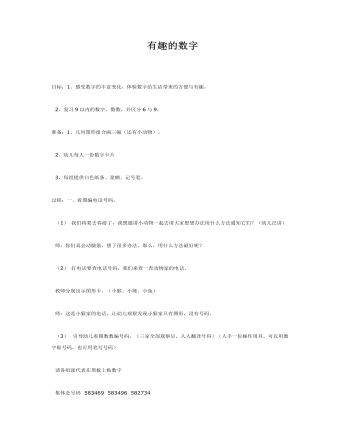
中班数学教案:有趣的数字
2、复习9以内的数字、数数,并区分6与9。准备:1、几何图形组合画三幅(还有小动物)。 2、幼儿每人一份数字卡片 3、每组提供白色纸条、浆糊、记号笔。过程:一、看图编电话号码。 (1) 我们将要去春游了,我想邀请小动物一起去请大家想想办法用什么方法通知它们?(幼儿泛讲) 师:你们真会动脑筋,想了很多办法,那么,用什么方法最好呢?
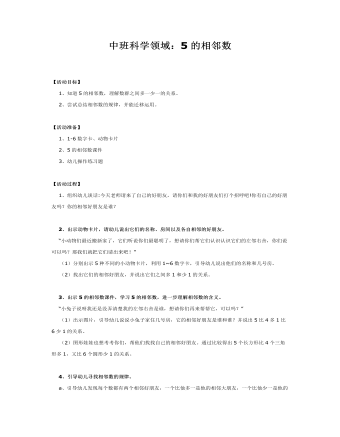
中班数学教案:5的相邻数
【活动准备】 1、1-6数字卡、动物卡片 2、5的相邻数课件 3、幼儿操作练习题 【活动过程】 1、组织幼儿谈话:今天老师请来了自己的好朋友,请你们和我的好朋友们打个招呼吧!你有自己的好朋友吗?你的相邻好朋友是谁? 2、出示动物卡片,请幼儿说出它们的名称、房间以及各自相邻的好朋友。 “小动物们最近搬新家了,它们听说你们最聪明了,想请你们帮它们认识认识它们的左邻右舍,你们说可以吗?那我们就把它们请出来吧!” (1)分别出示5种不同的小动物卡片,利用1~6数字卡,引导幼儿说出他们的名称和几号房。
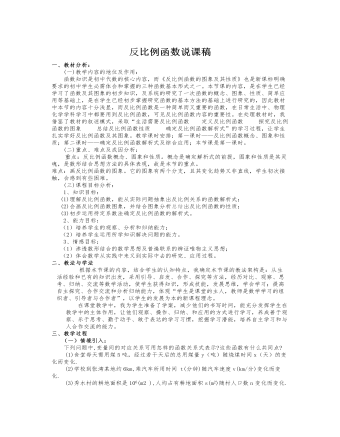
反比例函数说课稿
二)重点、难点及成因分析:重点:反比例函数概念、图象和性质。概念是确定解析式的前提,图象和性质是其灵魂,是数形结合思想方法的具体表现,故是本节的重点。难点:画反比例函数的图象。它的图象有两个分支,且其变化趋势又非直线,学生初次接触,会感到有些困难。(


